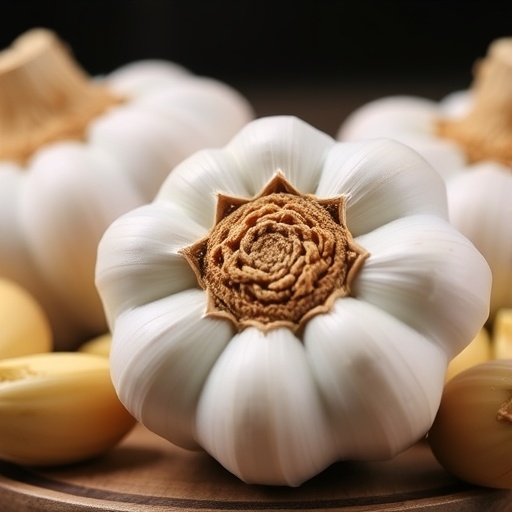A groundbreaking study has emerged that delves into the remarkable properties of aged garlic extract and its multifaceted role as an antimicrobial agent against oral bacteria. Researchers, led by Sunil M. along with colleagues Kurangi B. and Dodamani S., have undertaken an in-vitro examination to explore how this natural substance can combat not only the growth of harmful bacteria in the oral cavity but also the formation of biofilms that contribute significantly to oral diseases. This research has profound implications for dental health, perhaps offering an effective herbal alternative to conventional antibiotics.
The potential health benefits of garlic have been studied for centuries, with various cultures recognizing its medicinal properties. However, aged garlic extract, in particular, is gaining traction in scientific circles, largely due to its enhanced bioavailability and stability compared to fresh garlic. The process of aging garlic involves a careful method of fermentation that transforms its chemical composition, yielding powerful antioxidants and sulfur compounds. These elements are believed to play a crucial role in the extract’s ability to inhibit pathogenic bacteria.
Recent findings indicate that oral hygiene may be significantly improved by incorporating aged garlic extract into daily regimens. The in-vitro study suggests that aged garlic extract has the potency to disrupt bacterial membranes and hinder the growth of microbiological threats that commonly reside in the oral cavity. Notably, the extract demonstrated efficacy against well-known pathogens such as Streptococcus mutans and Porphyromonas gingivalis. These bacteria are notorious for their association with dental caries and periodontal disease, making the extract a promising candidate for oral health strategies.
One of the standout aspects of this research is the focus on the biofilm-inhibiting properties of aged garlic extract. Biofilms are clusters of bacteria that adhere to surfaces and encapsulate themselves within a protective matrix, making them particularly resilient against traditional antibacterial therapies. The presence of biofilms in the oral cavity complicates treatment regimens, as they allow bacteria to persist, leading to chronic infections. The study highlights how aged garlic extract can effectively penetrate this biofilm structure, disrupting its formation and ultimately reducing the bacterial load in the mouth.
Moreover, findings surrounding the cytotoxicity of aged garlic extract have been illuminating. The researchers aimed to quantify the extract’s toxicity levels on human cells to ensure its safety for consumption. Results show that the extract possesses low cytotoxicity, indicating that it can potentially be utilized without harmful side effects. This balance between efficacy against oral pathogens and safety for human cells is a crucial factor for the acceptance of any new therapeutic agent in dental care.
Another intriguing component of this research is the assessment of the substantivity of aged garlic extract. Substantivity refers to the duration the active compounds remain effective in the oral cavity after application. The study indicates that aged garlic extract maintains its antibacterial properties over prolonged periods, thereby providing a sustained anti-bacterial effect. This characteristic is essential when considering applications such as mouthwashes or dental treatments, offering long-lasting protection against oral pathogens.
The implications of such findings are vast, opening new avenues for the development of holistic oral health products. As the world becomes increasingly wary of antibiotic resistance, the exploration of plant-based, natural alternatives is more crucial than ever. Aged garlic extract presents a viable solution, potentially lowering the risk of antibiotic overuse while still granting significant antibacterial protection.
With consumer demand for natural health products on the rise, this study could spur further research into the practical applications of aged garlic extract in dental hygiene products. The adaptability of this extract suggests that it could be incorporated into various forms, from toothpaste to mouth rinses, thereby broadening its reach within the market.
In conclusion, the prospects for aged garlic extract in dental healthcare are promising, as demonstrated by the comprehensive findings of this in-vitro study. The ability to combat oral bacteria, inhibit biofilm formation, and do so with minimal cytotoxic effects represents a monumental leap in the quest for effective, natural alternatives to conventional treatments. Future research will undoubtedly build upon these findings, paving the way for innovative dental care solutions driven by nature.
As public awareness grows regarding the benefits of herbal remedies, studies like these are instrumental in reinforcing the efficacy of ancient wisdom backed by modern science. The call for natural dental care solutions is gaining momentum, and aged garlic extract stands at the forefront of this revolution, ready to redefine approaches to oral hygiene.
In the broader context of global health, promoting natural remedies such as aged garlic extract could significantly impact health outcomes, particularly in vulnerable populations where access to pharmaceuticals is limited. Ensuring that such beneficial extracts are sustainably harvested and integrated into health care will be essential in the coming years.
As we continue to explore the myriad possibilities that nature offers through substances like aged garlic extract, the quest for improved overall health – one study at a time – pushes forth into the future, backed by not only tradition but also rigorous scientific inquiry.
In summary, this in-vitro research presents a compelling case for incorporating aged garlic extract into our approach to oral health, potentially offering a potent tool in the prevention and treatment of oral diseases while aligning with growing global interests in sustainable and natural solutions to health care.
Subject of Research: Aged garlic extract and its effects on oral bacteria, biofilm formation, and cytotoxicity.
Article Title: Antimicrobial, antibiofilm, cytotoxicity, and substantivity of aged garlic extract against oral bacteria: an in-vitro study.
Article References:
Sunil, M., Kurangi, B., Dodamani, S. et al. Antimicrobial, antibiofilm, cytotoxicity, and substantivity of aged garlic extract against oral bacteria: an in-vitro study.BMC Complement Med Ther 25, 266 (2025). https://doi.org/10.1186/s12906-025-05012-8
Image Credits: AI Generated
DOI: 10.1186/s12906-025-05012-8
Keywords: Aged garlic extract, oral bacteria, antimicrobial properties, biofilm inhibition, cytotoxicity, substantivity, natural remedies.




